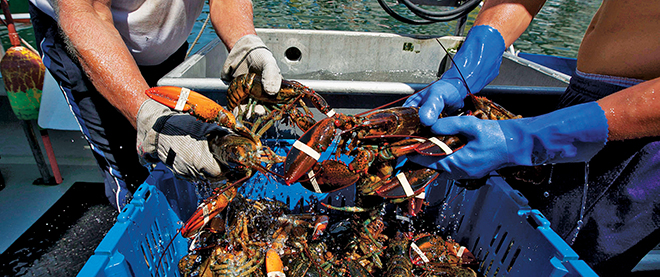
In Nova Scotia, locals will tell you, lobsters used to be poor-man’s food, and prisoners were once fed so much of it that they rioted. In his celebrated essay “Consider the Lobster,” David Foster Wallace states that “even in the harsh penal environment of early America, some colonies had laws against feeding lobsters to inmates more than once a week because it was thought to be cruel and unusual, like making people eat rats.”
In the restaurants of Canadian cities, the experience is the opposite—lobster is purveyed as a luxury food. A bit of claw, or a couple of slices of tail arrive, balanced on a carefully sculpted tower of julienne vegetables and a cappuccino froth, with an altogether heftier bill that comes later. Poached lobster at Vancouver’s C Restaurant will set you back $38. A couple of “lobster spoons,” the morsels braised in butter with vermouth, will cost a diner at Mark McEwan’s restaurant One, in Toronto, $26 before tax and tip, and a lobster carbonara $38.
Compare these dishes with others on the same menus and you will see that plates featuring Atlantic lobster at One sell for more than others featuring lamb or steak tartare, and at C for more than twice the price of “Pacific fish & chips.” And yet lobster is wholesaling in the Atlantic provinces at record low prices. Matthew Theriault, whose lobster-fishing rig Beth and Lyne sails out of Digby, N.S., into St. Marys Bay and the Bay of Fundy, has kept meticulous records that show the price he gets now is down a third since its 2007 peak of roughly $6 per pound. Today lobster is easily available for retail at $5 a pound in Digby and for less than $10 a pound in big city superstores—about the same price as haddock and less than cod, and half or even a third the price of lamb and beef.
Says one industry insider, unperturbed, “Wholesalers aren’t charging much, probably close to $5 per pound, and if the restaurants charge $20 for the same, that’s not really out of step with anything else they put on the plate. A 25 per cent food cost is pretty basic and a lot less of a markup than, say, an $18 pizza at a Toronto pizzeria that only costs management a dollar.”
And yet the glut of lobsters in both the American and Canadian markets is unprecedented, at least in this and the last century, a phenomenon that is not reflected at upmarket city restaurants. In 2010, the landing of 64,000 metric tonnes was three times the take of the mid-1970s. Lobster fishermen are by nature a tight-lipped bunch, but local accounts suggest 2011’s was a record catch, and this year’s may well be larger.
Neither Fisheries and Oceans Canada nor local fishermen are quite able to explain augmented hauls that are likely more than cyclical. Harold “Junior” Theriault, the popular MLA for Digby, and instrumental for 35 years in Lobster Fishing Area 34 (which stretches along the Bay of Fundy from Digby to Shelburne on the South Shore and is likely the most lucrative in all of Canada), suspects the depletion of cod, a natural predator of lobster larvae, to be the cause, and a rise in the temperature of the Bay of Fundy water to be the reason for soft-shelled lobster shedding twice a year, depressing prices even more.
Marty Gidney, who minds the Little River holding pound of the Fisherman’s Market, the Nova Scotian wholesaler, attributes the record catches to an excess of licences in the district. “Nearly a thousand boats landing 1,200 lb. a day. There’s just too much of it.” Gidney is skeptical about the disappearing groundfish as predator theory, however. “What are the lobster eating?” says Gidney. “They eat the poops and the crap on the bottom. So what are they eating now?”
“Maybe each other?” says Junior Theriault, with a throaty laugh.
A number of factors have combined to create today’s perfect storm of imperfect demand, the economic recession having worsened a situation in which the size of the catch has risen, though hardly on pace with costs. Fuel prices alone have skyrocketed—double today what they were when the price of lobster started its descent in 2008. The landing of inferior soft-shell lobsters in Maine and many Canadian districts is, according to Matthew Theriault, “all going to the processors and flooding them with a poor-quality product,” affecting even the excellent hard-shell product of District 34. Thus the bountiful catch is all the more frustrating. A harvest the fishermen did not dare dream of a few years ago is now, despite its mass, worth less.
Still, lobster is being sold as a luxury food, its exorbitant cost a part of the appeal when a little price elasticity on the part of the restaurateur might actually bolster demand and help the trade. Even in Digby, yards from the wharf where the draggers and the lobster boats come in, the prized crustacean is being offered in restaurants at $19 to $25 a pound. Diners extracting every delicious hidden smidgen from lobsters—found in the 19th century in such “unbelievable abundance” that, writes Wallace, the ground would be littered with them after hard storms (as happened a couple of years ago in the seaside town of Petit-Rocher, N.B.)—are proving themselves suckers of another kind, paying for food that is so underpriced at the moment that it might as well be served in prisons again.